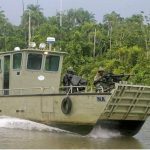Tourists enjoying the picture postcard views of lakes Lucerne, Thun or Neuchatel might be surprised to learn what lies beneath those pristine alpine waters.
For years the Swiss military used the lakes as dumping grounds for old munitions, believing it could be disposed of safely there.
In Lake Lucerne alone there are an estimated 3,300 tonnes of munition, and 4,500 tonnes in the waters of Neuchatel, which the Swiss air force used for bombing practice until 2021.
Some munitions are at depths of 150 to 220 metres, but others in Lake Neuchatel are just six or seven metres below the surface.
Now, the Swiss defence department is offering 50,000 francs (£45,000) in prize money for the best idea to get it out.
The best three ideas for a safe and environmental solution to retrieve the munitions will share the prize pot – but the salvage operation is expected to cost billions.
The fact that so many rounds were dumped in Swiss lakes – Brienz being another of them – has been known about for decades, though people have asked questions about safety more recently.
Retired Swiss geologist Marcos Buser, who advised the government on this topic, wrote a research paper ten years ago warning of the dangers of the dumps.
The munitions pose two risks, he said. First, despite the fact it is underwater, there is still a risk of explosion, because in many cases “the army did not remove the fuses before dumping the munition”.
Then there’s water and soil contamination – there is a real chance that highly toxic TNT could pollute the lake water and the sediment.
The Swiss government acknowledges that factors including poor visibility, magnetic iron and individual ammunition weights “represent major challenges for environmentally friendly ammunition recovery”.
An assessment of possible recovery techniques in 2005 showed that all proposed solutions for ammunition recovery posed severe risks for the sensitive ecosystems of the lakes.
Tourists enjoying the picture postcard views of lakes Lucerne, Thun or Neuchatel might be surprised to learn what lies beneath those pristine alpine waters.
For years the Swiss military used the lakes as dumping grounds for old munitions, believing it could be disposed of safely there.
In Lake Lucerne alone there are an estimated 3,300 tonnes of munition, and 4,500 tonnes in the waters of Neuchatel, which the Swiss air force used for bombing practice until 2021.
Some munitions are at depths of 150 to 220 metres, but others in Lake Neuchatel are just six or seven metres below the surface.
Now, the Swiss defence department is offering 50,000 francs (£45,000) in prize money for the best idea to get it out.
The best three ideas for a safe and environmental solution to retrieve the munitions will share the prize pot – but the salvage operation is expected to cost billions.
The fact that so many rounds were dumped in Swiss lakes – Brienz being another of them – has been known about for decades, though people have asked questions about safety more recently.
Retired Swiss geologist Marcos Buser, who advised the government on this topic, wrote a research paper ten years ago warning of the dangers of the dumps.
The munitions pose two risks, he said. First, despite the fact it is underwater, there is still a risk of explosion, because in many cases “the army did not remove the fuses before dumping the munition”.
Then there’s water and soil contamination – there is a real chance that highly toxic TNT could pollute the lake water and the sediment.
The Swiss government acknowledges that factors including poor visibility, magnetic iron and individual ammunition weights “represent major challenges for environmentally friendly ammunition recovery”.
An assessment of possible recovery techniques in 2005 showed that all proposed solutions for ammunition recovery posed severe risks for the sensitive ecosystems of the lakes.
Tourists enjoying the picture postcard views of lakes Lucerne, Thun or Neuchatel might be surprised to learn what lies beneath those pristine alpine waters.
For years the Swiss military used the lakes as dumping grounds for old munitions, believing it could be disposed of safely there.
In Lake Lucerne alone there are an estimated 3,300 tonnes of munition, and 4,500 tonnes in the waters of Neuchatel, which the Swiss air force used for bombing practice until 2021.
Some munitions are at depths of 150 to 220 metres, but others in Lake Neuchatel are just six or seven metres below the surface.
Now, the Swiss defence department is offering 50,000 francs (£45,000) in prize money for the best idea to get it out.
The best three ideas for a safe and environmental solution to retrieve the munitions will share the prize pot – but the salvage operation is expected to cost billions.
The fact that so many rounds were dumped in Swiss lakes – Brienz being another of them – has been known about for decades, though people have asked questions about safety more recently.
Retired Swiss geologist Marcos Buser, who advised the government on this topic, wrote a research paper ten years ago warning of the dangers of the dumps.
The munitions pose two risks, he said. First, despite the fact it is underwater, there is still a risk of explosion, because in many cases “the army did not remove the fuses before dumping the munition”.
Then there’s water and soil contamination – there is a real chance that highly toxic TNT could pollute the lake water and the sediment.
The Swiss government acknowledges that factors including poor visibility, magnetic iron and individual ammunition weights “represent major challenges for environmentally friendly ammunition recovery”.
An assessment of possible recovery techniques in 2005 showed that all proposed solutions for ammunition recovery posed severe risks for the sensitive ecosystems of the lakes.
Tourists enjoying the picture postcard views of lakes Lucerne, Thun or Neuchatel might be surprised to learn what lies beneath those pristine alpine waters.
For years the Swiss military used the lakes as dumping grounds for old munitions, believing it could be disposed of safely there.
In Lake Lucerne alone there are an estimated 3,300 tonnes of munition, and 4,500 tonnes in the waters of Neuchatel, which the Swiss air force used for bombing practice until 2021.
Some munitions are at depths of 150 to 220 metres, but others in Lake Neuchatel are just six or seven metres below the surface.
Now, the Swiss defence department is offering 50,000 francs (£45,000) in prize money for the best idea to get it out.
The best three ideas for a safe and environmental solution to retrieve the munitions will share the prize pot – but the salvage operation is expected to cost billions.
The fact that so many rounds were dumped in Swiss lakes – Brienz being another of them – has been known about for decades, though people have asked questions about safety more recently.
Retired Swiss geologist Marcos Buser, who advised the government on this topic, wrote a research paper ten years ago warning of the dangers of the dumps.
The munitions pose two risks, he said. First, despite the fact it is underwater, there is still a risk of explosion, because in many cases “the army did not remove the fuses before dumping the munition”.
Then there’s water and soil contamination – there is a real chance that highly toxic TNT could pollute the lake water and the sediment.
The Swiss government acknowledges that factors including poor visibility, magnetic iron and individual ammunition weights “represent major challenges for environmentally friendly ammunition recovery”.
An assessment of possible recovery techniques in 2005 showed that all proposed solutions for ammunition recovery posed severe risks for the sensitive ecosystems of the lakes.
Tourists enjoying the picture postcard views of lakes Lucerne, Thun or Neuchatel might be surprised to learn what lies beneath those pristine alpine waters.
For years the Swiss military used the lakes as dumping grounds for old munitions, believing it could be disposed of safely there.
In Lake Lucerne alone there are an estimated 3,300 tonnes of munition, and 4,500 tonnes in the waters of Neuchatel, which the Swiss air force used for bombing practice until 2021.
Some munitions are at depths of 150 to 220 metres, but others in Lake Neuchatel are just six or seven metres below the surface.
Now, the Swiss defence department is offering 50,000 francs (£45,000) in prize money for the best idea to get it out.
The best three ideas for a safe and environmental solution to retrieve the munitions will share the prize pot – but the salvage operation is expected to cost billions.
The fact that so many rounds were dumped in Swiss lakes – Brienz being another of them – has been known about for decades, though people have asked questions about safety more recently.
Retired Swiss geologist Marcos Buser, who advised the government on this topic, wrote a research paper ten years ago warning of the dangers of the dumps.
The munitions pose two risks, he said. First, despite the fact it is underwater, there is still a risk of explosion, because in many cases “the army did not remove the fuses before dumping the munition”.
Then there’s water and soil contamination – there is a real chance that highly toxic TNT could pollute the lake water and the sediment.
The Swiss government acknowledges that factors including poor visibility, magnetic iron and individual ammunition weights “represent major challenges for environmentally friendly ammunition recovery”.
An assessment of possible recovery techniques in 2005 showed that all proposed solutions for ammunition recovery posed severe risks for the sensitive ecosystems of the lakes.
Tourists enjoying the picture postcard views of lakes Lucerne, Thun or Neuchatel might be surprised to learn what lies beneath those pristine alpine waters.
For years the Swiss military used the lakes as dumping grounds for old munitions, believing it could be disposed of safely there.
In Lake Lucerne alone there are an estimated 3,300 tonnes of munition, and 4,500 tonnes in the waters of Neuchatel, which the Swiss air force used for bombing practice until 2021.
Some munitions are at depths of 150 to 220 metres, but others in Lake Neuchatel are just six or seven metres below the surface.
Now, the Swiss defence department is offering 50,000 francs (£45,000) in prize money for the best idea to get it out.
The best three ideas for a safe and environmental solution to retrieve the munitions will share the prize pot – but the salvage operation is expected to cost billions.
The fact that so many rounds were dumped in Swiss lakes – Brienz being another of them – has been known about for decades, though people have asked questions about safety more recently.
Retired Swiss geologist Marcos Buser, who advised the government on this topic, wrote a research paper ten years ago warning of the dangers of the dumps.
The munitions pose two risks, he said. First, despite the fact it is underwater, there is still a risk of explosion, because in many cases “the army did not remove the fuses before dumping the munition”.
Then there’s water and soil contamination – there is a real chance that highly toxic TNT could pollute the lake water and the sediment.
The Swiss government acknowledges that factors including poor visibility, magnetic iron and individual ammunition weights “represent major challenges for environmentally friendly ammunition recovery”.
An assessment of possible recovery techniques in 2005 showed that all proposed solutions for ammunition recovery posed severe risks for the sensitive ecosystems of the lakes.
Tourists enjoying the picture postcard views of lakes Lucerne, Thun or Neuchatel might be surprised to learn what lies beneath those pristine alpine waters.
For years the Swiss military used the lakes as dumping grounds for old munitions, believing it could be disposed of safely there.
In Lake Lucerne alone there are an estimated 3,300 tonnes of munition, and 4,500 tonnes in the waters of Neuchatel, which the Swiss air force used for bombing practice until 2021.
Some munitions are at depths of 150 to 220 metres, but others in Lake Neuchatel are just six or seven metres below the surface.
Now, the Swiss defence department is offering 50,000 francs (£45,000) in prize money for the best idea to get it out.
The best three ideas for a safe and environmental solution to retrieve the munitions will share the prize pot – but the salvage operation is expected to cost billions.
The fact that so many rounds were dumped in Swiss lakes – Brienz being another of them – has been known about for decades, though people have asked questions about safety more recently.
Retired Swiss geologist Marcos Buser, who advised the government on this topic, wrote a research paper ten years ago warning of the dangers of the dumps.
The munitions pose two risks, he said. First, despite the fact it is underwater, there is still a risk of explosion, because in many cases “the army did not remove the fuses before dumping the munition”.
Then there’s water and soil contamination – there is a real chance that highly toxic TNT could pollute the lake water and the sediment.
The Swiss government acknowledges that factors including poor visibility, magnetic iron and individual ammunition weights “represent major challenges for environmentally friendly ammunition recovery”.
An assessment of possible recovery techniques in 2005 showed that all proposed solutions for ammunition recovery posed severe risks for the sensitive ecosystems of the lakes.
Tourists enjoying the picture postcard views of lakes Lucerne, Thun or Neuchatel might be surprised to learn what lies beneath those pristine alpine waters.
For years the Swiss military used the lakes as dumping grounds for old munitions, believing it could be disposed of safely there.
In Lake Lucerne alone there are an estimated 3,300 tonnes of munition, and 4,500 tonnes in the waters of Neuchatel, which the Swiss air force used for bombing practice until 2021.
Some munitions are at depths of 150 to 220 metres, but others in Lake Neuchatel are just six or seven metres below the surface.
Now, the Swiss defence department is offering 50,000 francs (£45,000) in prize money for the best idea to get it out.
The best three ideas for a safe and environmental solution to retrieve the munitions will share the prize pot – but the salvage operation is expected to cost billions.
The fact that so many rounds were dumped in Swiss lakes – Brienz being another of them – has been known about for decades, though people have asked questions about safety more recently.
Retired Swiss geologist Marcos Buser, who advised the government on this topic, wrote a research paper ten years ago warning of the dangers of the dumps.
The munitions pose two risks, he said. First, despite the fact it is underwater, there is still a risk of explosion, because in many cases “the army did not remove the fuses before dumping the munition”.
Then there’s water and soil contamination – there is a real chance that highly toxic TNT could pollute the lake water and the sediment.
The Swiss government acknowledges that factors including poor visibility, magnetic iron and individual ammunition weights “represent major challenges for environmentally friendly ammunition recovery”.
An assessment of possible recovery techniques in 2005 showed that all proposed solutions for ammunition recovery posed severe risks for the sensitive ecosystems of the lakes.













